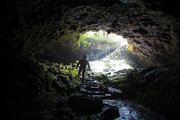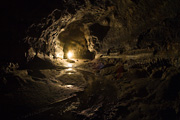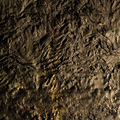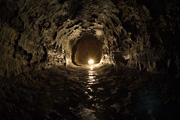|
December 2007: A Quick Visit to Lower Ape Cave
|
 |
Into the Depths
The entrance to Ape Cave features a short metal staircase. Lava tube caves like Ape Cave aren't very deep due to the way they form. The cave snakes along just below the forest floor.
|
|
 |
Swirling Path
Water is slowly re-shaping Ape Cave. In the rainy season, water seeps through the thin forest floor, and drips from the ceiling of the cave. A small creek can form along the bottom of the cave.
|
|
 |
Lava Worms
The walls of the cave echo the molten forces present at its formation.
|
|
 |
Stuck
A boulder is stuck in the narrow ceiling opening of Ape Cave... Just one of the many tiny wonders along the way.
|
|
 |
At the End of the Tunnel
At the end, the cave abruptly narrows into a solid dead-end.
|
|
|
May 2004: Exploring Upper Ape Cave
|
 |
Lighting the Way
Ape cave is a great place to explore on a rainy day... The upper section of the cave is a bit more rugged than the lower section. The route is still walkable - no special equipment is required - but there are a lot of uneven footings, and boulders to climb over. Here, a group of boy scouts heads up the cave, their headlamps making streaks through the darkness.
|
|
 |
In the Tube
The upper cave is also more varied in the amount of space available for ambulation. In some places, one needs to crouch down or turn sideways and squeeze through narrow openings.
|
|
 |
Around the Next Bend
We brought along a lantern for this trip. Generally, bringing a lantern is a really good idea (as lanterns throw off much more light than any flashlight)... provided you have a couple back-up light sources handy. During our trip, the screw holding the handle of the lantern became loose, and the lantern crashed to the cave floor. The glass broke, and the lantern was no longer usable. Luckily, we had other light sources available, and were near the end of our trip.
|
|
 |
Window to Another World
Upper Ape Cave is a little over a mile long, a hiking trail connects the openings at either end. This "sun roof" is near the upper end of the cave. Although, on this day, it was more like a "rain roof".
|
|
|
June 2003: A Visit to June Lake and Ape Cave
|
 |
June Lake
The area south of Mt. St. Helens was not severly impacted from the 1980 eruption (the eruption was primarily directed to the north). A number of trails criss-cross through the area. One of those goes by June Lake, pictured here. A waterfall pours into the lake at its far end.
|
|
 |
Mini-Slot
This formation reminded me of southwest desert slot canyons... except that it's in the northwest, in volcanic basalt. Plus, these "slots" weren't very large compared to their southwestern cousins.
|
|
 |
Belly of the Earth
Ape Cave is a lava tube cave south of Mt. St. Helens. It's the longest continuous lava tube cave in North America - over 2 miles long!
|
|
 |
Light in the Darkness
When lava flows down a volcano, the outside of the lava cools and hardens into rock while the lava underneath continues to flow. If the liquid lava then drains away before hardening, a hollow tube is formed.
|
|
 |
Crumbling Wall
Here, a piece of the cave wall has cracked open. Ape cave was named after nearby Ape Canyon. That was named because of an incident back in the 1920's when a couple of boys dressed up as Sasquatch and threw rocks at some miners. The hoax wasn't revealed until the 1980's, when one of the boys (then an old man) admitted he was one of the culprits.
|
|
Where is it?
The "Ape" area is my name for the area just south of Mt. St. Helens in southern Washington state. This includes Ape Canyon, Lava Canyon, Ape Cave, a section of the Loowit trail (which circles the mountain), and some other trails. Head north on Road 83 from the town of Cougar, and follow the signs for Ape Cave. The other trailheads are along this road as well..
|
Before you go...
You'll need a NW forest pass to park at the trailheads. Ape Cave is administered by the Mt. St. Helens National Monument, but if you have a NW forest pass, you can get in without paying the $3/person fee. The cave is absolutely dark, so bring a few light sources. I'd recommend bringing a propane lantern as your primary light source - it's the best way to evenly illuminate the area around you & makes the experience much more enjoyable - because you can get a better sense of where you are. If you want some solitude in Ape Cave (it's a popular destination), try visiting in the early morning, in the off season, or try sticking to the upper cave. Being underground, the cave is a great place to visit when it's raining!
|